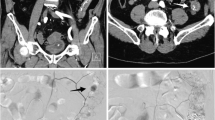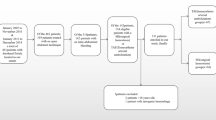Abstract
Purpose
We aimed to estimate the usefulness of transcatheter arterial embolization (TAE) in patients with postoperative abdominal hemorrhage and to evaluate the effects of pancreatic fistula on clinical outcomes and angiographic findings.
Materials and Methods
We enrolled 22 patients (20 males and 2 females; mean age 63 years; range 25–86 years), who underwent transarterial angiography for postoperative hemorrhage after abdominal surgery. This group corresponded to 28 procedures. Technical and clinical success rates were calculated, and clinical findings and outcomes were compared between patients with and without a pancreatic fistula.
Results
Pre-interventional CT was performed in all patients before first angiography, and the location of the bleeding was identified in all but one patient. Active arterial bleeding, identified by extravasation of contrast agent (n = 12), pseudoaneurysm formation (n = 12), and arterial wall irregularity (n = 2) were detected in 28 angiographic procedures, and embolization was performed in 26 instances. Various embolization techniques such as isolation, packing, embolization, and stentgraft implantation were performed. The technical and clinical success rates were 96% (25/26 procedures) and 82% (18/22 patients), respectively. In hemodynamically unstable patients (shock index: heart rate/systolic blood pressure > 1), a 92% (12/13 cases) technical success rate was achieved. There were no significant differences in any evaluated parameters between patients with and without pancreatic fistula.
Conclusion
TAE is a safe and effective for treating postoperative hemorrhage even in patients with hemodynamic instability and pancreatic fistula. Additionally, pre-interventional CT is useful for effective, consecutive interventions.





Similar content being viewed by others
References
Yang J, Zhang XH, Huang YH, Chen B, Xu JB, Chen CQ, Cai SR, Zhan WH, He YL, Ma JP. Diagnosis and treatment of abdominal arterial bleeding after radical gastrectomy: a retrospective analysis of 1875 consecutive resections for gastric cancer. J Gastrointest Surg. 2016;20:510–20. https://doi.org/10.1007/s11605-015-3049-z.
Tasu JP, Vesselle G, Herpe G, Ferrie JC, Chan P, Boucebci S, Velasco S. Postoperative abdominal bleeding. Diagn Interv Imaging. 2015;96:823–31. https://doi.org/10.1016/j.diii.2015.03.013.
Yekebas EF, Wolfram L, Cataldegirmen G, Habermann CR, Bogoevski D, Koenig AM, Kaifi J, Schurr PG, Bubenheim M, Nolte-Ernsting C, Adam G, Izbicki JR. Postpancreatectomy hemorrhage: diagnosis and treatment an analysis in 1669 consecutive pancreatic resections. Ann Surg. 2007;246:269–80. https://doi.org/10.1097/01.sla.0000262953.77735.db.
Tien YW, Lee PH, Yang CY, Ho MC, Chiu YF. Risk factors of massive bleeding related to pancreatic leak after pancreaticoduodenectomy. J Am Coll Surg. 2005;201:554–9. https://doi.org/10.1016/j.jamcollsurg.2005.05.007.
Lee HG, Heo JS, Choi SH, Choi DW. Management of bleeding from pseudoaneurysms following pancreaticoduodenectomy. World J Gastroenterol. 2010;16:1239–44. https://doi.org/10.3748/wjg.v16.i10.1239.
Ding X, Zhu J, Zhu M, Li C, Jian W, Jiang J, Wang Z, Hu S, Jiang X. Therapeutic management of hemorrhage from visceral artery pseudoaneurysms after pancreatic surgery. J Gastrointest Surg. 2011;15:1417–25. https://doi.org/10.1007/s11605-011-1561-3.
Wei HK, Wang SE, Shyr YM, Tseng HS, Tsai WC, Chen TH, Su CH, Wu CW, Lui WY. Risk factors for post-pancreaticoduodenectomy bleeding and finding an innovative approach to treatment. Dig Surg. 2009;26:297–305. https://doi.org/10.1159/000228245.
Wellner UF, Kulemann B, Lapshyn H, Hoeppner J, Sick O, Makowiec F, Bausch D, Hopt UT, Keck T. Postpancreatectomy hemorrhage-incidence, treatment, and risk factors in over 1,000 pancreatic resections. J Gastrointest Surg. 2014;18:464–75. https://doi.org/10.1007/s11605-013-2437-5.
Zhou C-G, Shi H-B, Liu S, Yang Z-Q, Zhao L-B, Xia J-G, Zhou W-Z, Li Chun-Gao Zhou L-S, Li L-S. Transarterial embolization for massive gastrointestinal hemorrhage following abdominal surgery. World J Gastroenterol. 2013;19:6869–75. https://doi.org/10.3748/wjg.v19.i40.6869.
Belli AM, Markose G, Morgan R. The role of interventional radiology in the management of abdominal visceral artery aneurysms. Cardiovasc Intervent Radiol. 2012;35:234–43. https://doi.org/10.1007/s00270-011-0201-3.
De Castro SMM, Kuhlmann KFD, Busch ORC, Van Delden OM, Laméris JS, Van Gulik TM, Obertop H, Gouma DJ. Delayed massive hemorrhage after pancreatic and biliary surgery embolization or surgery? Ann Surg. 2005;241:85–91. https://doi.org/10.1097/01.sla.0000150169.22834.13.
Blanc T, Cortes A, Goere D, Sibert A, Pessaux P, Belghiti J, Sauvanet A. Hemorrhage after pancreaticoduodenectomy: when is surgery still indicated? Am J Surg. 2007;194:3–9. https://doi.org/10.1016/j.amjsurg.2006.08.088.
Hur S, Yoon CJ, Kang SG, Dixon R, Han HS, Yoon YS, Cho JY. Transcatheter arterial embolization of gastroduodenal artery stump pseudoaneurysms after pancreaticoduodenectomy: safety and efficacy of two embolization techniques. J Vasc Interv Radiol. 2011;22:294–301. https://doi.org/10.1016/j.jvir.2010.11.020.
Dohan A, Eveno C, Dautry R, Guerrache Y, Camus M, Boudiaf M, Gayat E, Le Dref O, Sirol M, Soyer P. Role and effectiveness of percutaneous arterial embolization in hemodynamically unstable patients with ruptured splanchnic artery pseudoaneurysms. Cardiovasc Intervent Radiol. 2015;38:862–70. https://doi.org/10.1007/s00270-014-1002-2.
Loffroy RF, Abualsaud BA, Lin MD, Rao P, Rao PP, Morgan RH, Rerknimitr R. Recent advances in endovascular techniques for management of acute nonvariceal upper gastrointestinal bleeding Recent advances in endovascular techniques for management of acute non- variceal upper gastrointestinal bleeding. World J Gastrointest Surg. 2011;3:89–100. https://doi.org/10.4240/wjgs.v3.i7.89.
Libicher M, Reichert V, Aleksic M, Brunkwall J, Lackner KJ, Gawenda M. Balloon occlusion of the celiac artery: a test for evaluation of collateral circulation prior endovascular coverage. Eur J Vasc Endovasc Surg. 2008;36:303–5. https://doi.org/10.1016/j.ejvs.2008.04.009.
Tajima T, Yoshimitsu K, Inokuchi H, Irie H, Nishie A, Hirakawa M, Ishigami K, Ushijima Y, Okamoto D, Honda H, Itoh H, Morita M, Kakeji Y. Microballoon occlusion test to predict colonic ischemia after transcatheter embolization of a ruptured aneurysm of the middle colic artery. Cardiovasc Intervent Radiol. 2008;31:828–32. https://doi.org/10.1007/s00270-008-9330-8.
Medsinge A, Zajko A, Orons P, Amesur N, Santos E. A case-based approach to common embolization agents used in vascular interventional radiology. Am J Roentgenol. 2014;203:699–708. https://doi.org/10.2214/AJR.14.12480.
Won Y, Lee SL, Kim Y, Ku YM. Clinical efficacy of transcatheter embolization of visceral artery pseudoaneurysms using N-butyl cyanoacrylate (NBCA). Diagn Interv Imaging. 2015;96:563–9. https://doi.org/10.1016/j.diii.2015.01.003.
Fujii Y, Shimada H, Endo I, Yoshida KI, Matsuo KI, Takeda K, Ueda M, Morioka D, Tanaka K, Togo S. Management of massive arterial hemorrhage after pancreatobiliary surgery: does embolotherapy contribute to successful outcome? J Gastrointest Surg. 2007;11:432–8. https://doi.org/10.1007/s11605-006-0076-9.
Tipaldi MA, Orgera G, Krokidis M, Rebonato A, Maiettini D, Vagnarelli S, Ambrongi C, Rossi M. Trans arterial embolization of non-variceal upper gastrointestinal bleeding: is the use of ethylene-vinyl alcohol copolymer as safe as coils? Cardiovasc Intervent Radiol. 2018. https://doi.org/10.1007/s00270-018-1981-5.
Pedersoli F, Isfort P, Keil S, Goerg F, Zimmermann M, Liebl M, Schulze-Hagen M, Schmeding M, Kuhl CK, Bruners P. Stentgraft implantation for the treatment of postoperative hepatic artery pseudoaneurysm. Cardiovasc Intervent Radiol. 2016;39:575–81. https://doi.org/10.1007/s00270-015-1274-1.
Hafezi-Nejad N, Fishman EK, Zaheer A. Imaging of post-operative pancreas and complication after pancreatic adenocarcinoma resection. Abdom Radiol. 2018;43:476–88. https://doi.org/10.1007/s00261-017-1378-y.
Yoon W, Jeong YY, Shin SS, Lim HS, Song SG, Jang NG, Kim JK, Kang HK. Acute massive gastrointestinal bleeding: detection and localization with arterial phase multi-detector row helical CT. Radiology. 2006;239:160–7. https://doi.org/10.1007/s00261-017-1378-y.
Funding
This study was not supported by any funding.
Author information
Authors and Affiliations
Corresponding author
Ethics declarations
Conflict of interest
The authors declare that they have no conflict of interest.
Ethical Approval
This retrospective study was approved by the institutional review board, and the requirement for written informed consent of subjects was waived off.
Consent for Publication
For this type of study, consent for publication is not required.
Rights and permissions
About this article
Cite this article
Chatani, S., Inoue, A., Ohta, S. et al. Transcatheter Arterial Embolization for Postoperative Bleeding Following Abdominal Surgery. Cardiovasc Intervent Radiol 41, 1346–1355 (2018). https://doi.org/10.1007/s00270-018-2019-8
Received:
Accepted:
Published:
Issue Date:
DOI: https://doi.org/10.1007/s00270-018-2019-8




